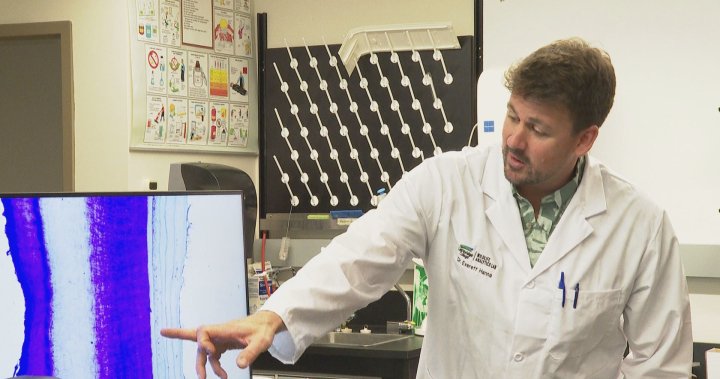[ad_1]
On Wednesday, a brand-new lab examining wildlife teeth opened at Lethbridge College. It’s the first of its kind in Canada.
“The Wildlife Analytics Lab is starting off focusing on cementum analysis, which is technical jargon for looking inside teeth to determine the age of animals,” said Dr. Everett Hanna, an Environmental Sciences instructor at Lethbridge College.
He explained like cement, cementum holds teeth in place, and inside there are annuli, the ring-like bands and spaces seen in tree trunks.
“Just like in a tree where we have growth rings, the same principles apply. Unfortunately with a tree you can just cut it and look at the rings, in a tooth you need to go through quite an elaborate chemical process to get at these annuli that are sort of embedded within the teeth roots,” said Hanna.
From there, the lab provides age estimates for wildlife mammals to those interested in the fee-for-service program. According to Hanna, this process is helpful for harvest allocation in hunting or disease management, and in some cases understanding reproductive history.
“In species like black bears, when females have young cubs and they’re lactating, the years in which they have those young and they’re lactating the annuli are closer together, so you can clearly see years when they have young and years where they don’t,” said Hanna.

The Alberta Professional Outfitters Society (APOS) provided $145,000 from their Wildlife Management Fund to fund the purchase of new equipment from Leica, as well as to hire student lab techs and a dedicated lab technician.
“That money was instrumental, it’s the reason we are where we are here today,” said Hanna.
Corey Jarvis, president of APOS explains it was an opportunity for a made-in-Alberta solution for a high demand area of research.
“We need to know and analyze, and Alberta needs that data before they can make good wildlife management decisions,” said Jarvis.
“You had to get an export permit in the past to ship wildlife parts to the states and the costs were in U.S. dollars and time and effort to get stuff down and back, so I think it will [mean] a lot more timely analysis potentially here as well, so the benefits are great all around I think on the program.”
Once the lab is in full operation Hanna has goals of analyzing 4,000 to 5,000 teeth per year and in the future, developing a process to help track migratory patterns.
“If we can enhance Canadian wildlife conservation through this contribution, train students, develop research opportunities, and grow this solution here in Lethbridge, I think those are all win-win-wins,” said Hanna.

© 2023 Global News, a division of Corus Entertainment Inc.
[ad_2]
Source link













































